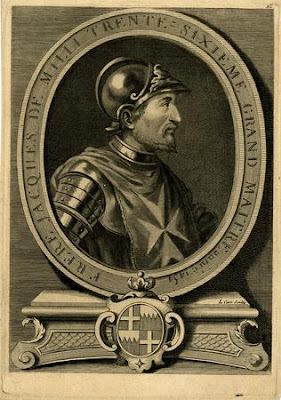1454. A noble French falconer. A spirited merchant’s daughter. And a fateful decision that changes their destiny forever.
A moment that will stay with me forever: one day, we entered the rebuilt palace of the knights and wandered through vast, formal chambers. We peeked into dim corridors where stone tablets carved with European knights’ coats-of-arms leaned haphazardly against the walls. Staring at those forgotten slabs of stone, I found myself wondering who the knights had been, where they had come from, and how they had died.
Knights Hospitaller palace, Rhodes Town, [Unsplash photo]
The Order of St. John of the Knights Hospitaller began in Jerusalem during the 1100s as a hospice for sick pilgrims. After gaining papal protection a century later, it expanded its operations to become both a religious and military organization, defending the crusader states in the Holy Land. As Muslims took over the crusader states, the Knights Hospitaller withdrew first to the Greek island of Rhodes and—after their expulsion by the Ottoman Turks in 1522—eventually regrouped in Malta.
The organization’s lifeblood was in Western Europe. Wealthy donors infused the Hospitallers with land, rights and revenues; their sons became knights of the Order and travelled to the Holy Land, Rhodes, and Malta to defend Christendom. Each European region or kingdom with ties to the Order was called a ‘tongue.’ France had three tongues: Ile-de-France, Auvergne, and Provence. During the era of Island of Gold, the Grand Master of the Knights Hospitaller was Jacques de Milly, a seasoned knight from Auvergne and a pivotal character in the novel.
Jacques de Milly [Wikipedia Commons]
One thing that surprised me in the course of my research was how few knights there were during the mid-fifteenth century. Rhodes Town (the largest community in Rhodes and the headquarters of the Order for two hundred years) housed about three hundred knights at that time. The bulk of their fighting force was made up of mercenaries, some of whom were recruited from overseas, while others known as ‘turcopoles’ were local men conscripted into service.
Most knights were wealthy second or third sons of noble families. Sending a son on a “tour” with the knights was both fashionable and a demonstration of piety. It was not glamorous, though. I found evidence of a young French knight who arrived in Rhodes only to be horrified by the brutality he witnessed. He wrote a letter home begging his parents not to send his younger brother to join him. They ignored his pleas and the boy was sent on to Rhodes as a page and later killed.
The knights were pirates, like most seafaring societies in the medieval Mediterranean. They raided Muslim villages in Turkey, Syria, and Egypt. They took captives and sold them as slaves (or kept them to build fortifications in Rhodes Town and work their sugar plantations). Mercenaries employed by the Order were allowed to keep much of what they stole. The Order was constantly engaged in negotiations with the Ottoman Turks and the Mamluks (the rulers of Egypt at the time), dealing with exchanges of prisoners and attempts to mitigate violence at sea. But both sides routinely broke their fragile agreements.
In Rhodes Town itself, the Grand Master and his brethren ruled the Order from the massive stone palace overlooking the harbor. Once a week, the Grand Master would meet with townsfolk to hear grievances, mediate disputes, and announce punishments and rewards. Inns housing knights, pilgrims, and other travelers were built along the ‘Street of the Knights’ leading up the hill to the palace.
Street of the Knights, Rhodes Town. [Unsplash photo]
The knights were feared, but they were also respected. As Christians, Rhodians were terrified of a Muslim takeover of their island, and the knights were a bulwark against that possibility.
When my characters Cédric and Sophie arrive in Rhodes in 1455, they discover an atmosphere of slowly-building tension and dread. The fall of Constantinople in 1454 to Sultan Mehmed II of Turkey sent shock waves throughout the Christian world. Cédric and Sophie learn that few in Rhodes Town are willing to speak the words aloud, but everyone is thinking: Will Rhodes be next?
The Turks struck Rhodes in 1480, but the Knights managed to hold them off. When they returned in 1522, things would be different. The Order was overwhelmed. After a long siege, they conceded defeat.
During the hundreds of years of Muslim occupation of Rhodes that followed, many Christian churches were demolished or transformed into mosques. The palace fell into disrepair. The beautiful Church of St. John that once stood adjacent to the palace vanished in the 19th century due to an explosion.
Medieval hospital in Rhodes Town Unsplash photo]
Amy Maroney
# # #
About the Author
Amy Maroney lives in the Pacific Northwest of the U.S. with her family, and spent many years as a writer and editor of nonfiction before turning her hand to historical fiction. She's currently obsessed with pursuing forgotten women artists through the shadows of history. When she's not diving down research rabbit holes, she enjoys hiking, drawing, dancing, and reading. Get The Promise, a free prequel novella to the Miramonde Series, and check out Amy’s blog here: https://www.amymaroney.com/. Connect with Amy on Facebook and Twitter @wilaroney







Such an interesting post.
ReplyDeleteThank you so much for hosting today's blog tour stop. We really appreciate all that you do.
Mary Anne
The Coffee Pot Book Club
Thanks so much for hosting me today, Tony!
ReplyDelete